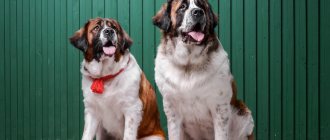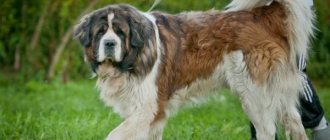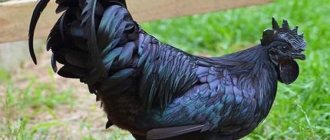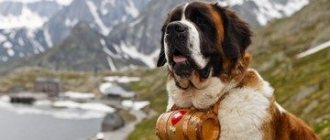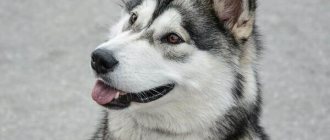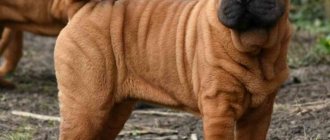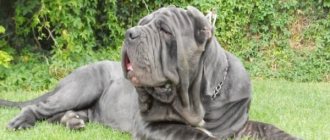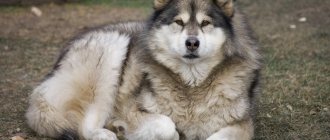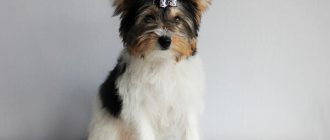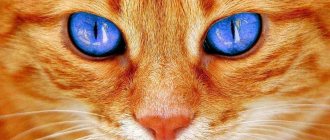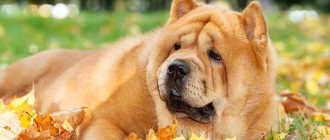Features of feeding
“Muscovites” are quite large dogs, which means their nutrition must be appropriate.
You need to feed your pet regularly; vitamins must be present in the diet. If you feed natural food, then in addition to this, the dog needs to be given special supplements with minerals and vitamin complexes. The diet should include meat, fish, fruits and vegetables, cereals, eggs, kidneys and liver. Dry food already contains all the necessary vitamins, so no additional supplements are required for this type of feeding.
Puppies should be fed 4 times a day, gradually reducing the amount to three, and then to two times.
Do I need salt?
The age-old question of all dog breeders is whether they need to add salt to their pet’s food. Every caring owner is concerned about how to diversify the dog’s food supply and how to please it. If your pet is happy to eat food with added salt and refuses bland food. Then, most likely, this is not spoilage, but a lack of salt in the body. Animals are very smart and know what is best for their body. But there are also pets who do not disdain salty sausage, and the owners will certainly pamper their pet.
Salt is important in a dog’s life, as it is responsible for hematopoiesis and promotes the secretion of gastric juice. Salt should be in the diet, but should not be tasted. If one piece does nothing, then four such pieces can lead to poisoning, kidney disease, and urinary tract diseases in the dog. Kidney stones and cystitis are a consequence of salty pet treats. If the dog regularly eats fresh meat, then it already contains as much salt as the body needs. When cooking meat, you should add 1/3 of the dose that you would add to yourself into the broth.
If you can't decide whether you need to add salt, think about how much treat comes from your table. For example, cheese, sausage, meat. If there is quite a lot, then you should not get carried away and add salt to your pet’s main food, because most of it has already been received with the treat. Mmm, porridge with meat
It is well known that the dog must have fresh water in sufficient quantities. It must be taken into account that if the pet consumes something additional that contains salt, it is necessary to increase the daily dose of salt.
Do not give or withhold salt to your dog thoughtlessly. It is necessary to consult a veterinarian, who will definitely prescribe a biochemical analysis. The results will make it clear whether salt can be added to the diet or whether it is completely contraindicated for the animal.
It is worth noting that when cooking porridge, you should add a little vegetable oil. This is very beneficial for the coat and eyes. You can add a little salt. Unless completely contraindicated by a veterinarian. This usually happens if the dog has kidney disease or urolithiasis.
Historical reference
The Great Patriotic War claimed many human lives; the damage in the world of cynology is not worth talking about. Large, service dogs were represented by literally single specimens. In the 40s, the Rottweiler or St. Bernard were wonders. At the same time, the state needed large, working dogs. Importing animals from abroad required serious financial investments, so the decision was made to develop a new breed. The initiative came “from above,” from the USSR Ministry of Defense. The order was signed and came into force in 1950.
The work of the breeders was based on experience and deep knowledge in animal science. The Moscow Guard Shepherd was bred using a number of dissimilar breeds: German and Caucasian Shepherds, St. Bernards and Newfoundlands, Greyhounds and Piebald Hounds. The “cocktail” of such different types of ancestors needed serious refinement, and the resulting offspring needed to be selected.
The program started at a military dog breeding school and kennel called “Red Star”. Responsible for carrying out breeding work were Ilyin N.A. and Bortnikov N.I. The working group was faced with a specific task - serious appearance, large dimensions, mobility, dexterity, endurance, unpretentiousness, presence of guard and security qualities.
Naturally, in the first litters, puppies were born that were similar to one or the other parent, that is, phenotypes. For further work, dogs born from the second generation were used. All four-legged animals that received good marks from canine experts remained in the nursery and underwent training and working tests. After recording all the nuances of interest in breeding journals, the dogs were transferred for service in various structures, but remained state property.
By 1950, the first working group of 5 dogs was formed in the nursery. All animals were born in the same litter and had disadvantages, but the overall assessment showed that the work was progressing successfully. It should be noted that close relatives were used in breeding, which required special criticality in the assessment. The working group faced a difficult stage - fixing the exterior, and most importantly, choosing the main breed characteristics and their refinement. In world practice, only breeds that have certain and obvious differences from their ancestors and already registered breeds achieve recognition. Therefore, not only mestizos, but also crossbreeds of several generations were allowed into factory activities.
In the mid-50s, Moscow Watchdog puppies were transferred by appointment, from the kennel to clubs and into the hands of proven, experienced amateur dog breeders. In return, the clubs supplied service dog puppies to the military dog breeding school. The joint work yielded positive results.
By the beginning of 1958, there were already 28 breeding sires living in the nursery. Taking their qualities together, experts compiled the first description of the breed. The document can hardly be called an official standard; rather, it was an action plan taking into account the work done. However, six months later, in May 1958, following long discussions and disputes, the first official breed standard was published.
Since 1960, the history of the breed began to develop more rapidly; from the “union” of a St. Bernard bitch and a Caucasian Shepherd dog, two excellent-looking puppies were obtained - Orslan and Onyx. Apparently, nature decided to give in to people and endow male dogs with strong, dominant genes. Further use of Orslan and Onyx resulted in surprisingly high-quality, uniform, healthy and balanced livestock.
Content
The parameters of the animal are such that it is unlikely to get along in a small apartment - at most in a spacious dwelling with many rooms. But it is convenient to keep pets in a spacious cottage or enclosure equipped with a booth. “Muscovites” are perfectly adapted to frosty winters: to survive them, it is enough to build a warm wooden box for your pet. It is important that the animal has a complete overview of the territory. If it lives indoors, you need a lounger in a secluded place, bright enough, but protected from drafts.
If an animal is involved in breeding work, it needs a spacious booth. Bitches of this breed produce numerous offspring, so it is wise to build a puppy pen. It is better to calculate the housing according to the individual size of the dog, but the standard ones are 135 cm / 100 cm / 95 cm - this is the width, depth and height of the booth. The manhole should have dimensions of 40/60 cm - width and height. The booth should be spacious enough, dry, and comfortable so that the animal can hide there from rain, wind, heat, and cold.
Although the “Muscovite” seems overweight and clumsy, she is very eager to move, unlike her St. Bernard ancestors, who get along well in an enclosure. It is especially necessary to walk a pet that lives in an apartment especially often and for a long time. The minimum walking time is 4 hours: this includes active games and jogging. 1.5 hours is enough for the inhabitants of the enclosure, provided that they move sufficiently in the allotted area.
Temperament and character
Every person who wants to have such a dog and live with it must understand the peculiarities of its character.
Attitude towards children and others
The Moscow Guard Dog can become a true friend for a child.
The breed is completely non-aggressive and treats both children and adults well. However, despite its calm nature, you should not leave the dog alone with the child. After all, the dog has an impressive size and weight, and therefore it can accidentally harm the baby.
Children should only play with the Moscow Watchdog under adult supervision.
Key facts
There are several key facts related to the temperament of this guard dog breed:
- Friendliness. The Russian Watchdog is very friendly and can get along with both people and other animals.
- Independence. When difficult situations arise, such a dog can quickly make decisions even without the owner’s intervention.
- Devotion. Representatives of this breed are very loyal and will not leave their owner until the end of their lives.
Important! For the Moscow watchdog to be truly loyal, you need to treat it with respect, without showing aggression.
Service characteristics
The breed is almost ideal for human service
The Moscow Watchdog is a breed with unique service characteristics that make it possible to train such dogs to protect territory or people.
Known for its service characteristics, among which are obedience and submission to the owner. If you raise and train your dog correctly, he will unquestioningly carry out any commands. These dogs also have a high level of intelligence. This allows them to learn quickly and absorb new information.
Buy | sell
| 5000 Zaporozhye1 March 2021 I am selling very cute and playful Moscow Watchdog puppies. Puppies were born on February 14, 2022. |
| I'll give it to good hands Moscow January 18, 2021 Hello! You weren’t looking for me?! And I’m really waiting for you! I’m a girl, Kassandra, Kasya, Kasya-Masya????. I’m six months old, cheerful, playful, I can grasp all sciences... |
| 25000 Voronezh21 May 2020 March 27, 2022 Puppies with great prospects were born! Ideal combination of blood: father: Triumph the Winner, mother: Molniya-Groza from Don-Grad. Puppies… |
| 30000 MoscowDecember 1, 2019 Purebred Moscow Watchdog puppies. BKO documents (FCI). Born 1.11.19. Puppies in Belarus, I will help with organizing delivery. On the phone… |
| 12000 ObninskOctober 11, 2019 Moscow Guard puppies for sale, born on September 3rd. They are already eating on their own. The breed is distinguished by excellent guarding qualities and selfless… |
| 15000 Voronezh23 January 2019 I offer gorgeous Moscow Guard puppies. 6 months. documentation. fully vaccinated. Very obedient and loyal dogs. They are excellent guard guards... |
| 10000 ChelyabinskNovember 19, 2018 A private breeding kennel offers Moscow Watchdog puppies for exhibitions, breeding, work, and just as a companion for the soul. In our… |
| 10000 SmolenskOctober 25, 2018 Purebred Moscow Watchdog puppies are looking for caring and loving homes. The puppies have excellent natural characteristics and a stable psyche. ... |
| 10000 Sudak4 January 2018 I will sell Moscow Guard puppies, branded, with all documents, vaccinated, a dog for those who need serious protection and a safe one who have children... |
| I'll give it to good hands Moscow July 18, 2017 Moscow and Moscow Region! Jessie still hopes to find the owners! The girl is about 6 months old, with a passport and vaccinations. Completely housebound, he only gnaws on his own bones and... |
| 5000 April 9, 2017 Unscheduled mating parents with documents, puppies 4 girls 1 boy born on January 10, 2022 there will be a large father mother and puppies can be viewed in… |
| 18000 March 22, 2017 For sale: Moscow Guard puppy (girl) from titled parents. RKF documents. Parents of the breeding kennel “Kingdom Tornado”. Very… |
| mating Lipetsk February 8, 2017 Looking for a male for mating |
| I'll give it to good handsDecember 13, 2016 If you started reading this ad, it means you want to get a dog!!! Please read this ad to the end. I beg for help in saving the puppies... |
| I will buy October 7, 2016 Required with documents. |
| 6000 Rostov-on-Don21 September 2016 Moscow Watchdog puppies |
| 8000 Dzhankoy1 July 2016 Moscow Guard puppies for sale from large parents with good working qualities and a balanced psyche. Born on May 12. The puppies are large... |
| 25000 Moscow17 June 2016 On May 08, 2016, MS puppies were born. RKF documents. Father: Fabulous Regiment Warrior (champion of the Russian Federation, champion of the RKF, champion of the National Club, ZKS-1, OKD-1, T-1. Mother:... |
| 25000 Smolensk31 May 2016 Reservations are open. There are girls, there are boys. Born May 08, 2016. Father: Fabulous Regiment Warrior (champion of the Russian Federation, champion of the RKF, champion of the National Club, ZKS... |
| 15000 Ufa31 October 2015 Moscow guard puppies, large, powerful, beautiful, with the mark and pedigree of the RKF - for protection, exhibitions and breeding. Moscow watchdog-… |
| 8000 Ekaterinburg12 October 2015 Selling puppies from purebred Moscow watchdog |
| 8000 EkaterinburgOctober 9, 2015 Puppies from purebred Moscow guard |
| 20000 September 28, 2015 Moscow Watchdog puppies for sale from titled parents! Date of birth August 1, 2015 Parents of aviary keeping, powerful, ... |
| matingSimferopol20 June 2015 Moscow Guard male (2 years old), looking for a girl for breeding. Dad Champion of Ukraine. My dog has a puppy card. I took it exclusively for protection... |
| 5000 Kamensk-Uralsky May 15, 2015 I sell Moscow Watchdog puppies, age 1.5 months. 2 girls and 5 boys. |
| 5000 Kurgan15 May 2015 I sell Moscow Watchdog puppies, age 1.5 months. 2 girls and 5 boys. |
| 5000 Chelyabinsk May 15, 2015 I sell Moscow Watchdog puppies, age 1.5 months. |
| 5000 Tyumen15 May 2015 I sell Moscow Watchdog puppies, age 1.5 months. |
| 5000 EkaterinburgMay 15, 2015 I sell Moscow Watchdog puppies, age 1.5 months. 2 girls and 5 boys. |
Moscow guard puppy12000 Krasnoyarsk May 10, 2015 Moscow guard puppy. Strong, bright, with good bones, promising children have a correct and very beautiful exterior without defects, large, ... |
Breed standard, appearance and photographs
Currently there are breed standards that are slightly different from each other:
- 1992 standard of the Russian Federation of service dog breeding with amendments and additions of the Russian Cynological Federation (RKF) from 1997, approved by the Ministry of Agriculture and Food of the RSFSR.
- Fédération Cynologique Internationale (FCI) standard.
According to the international standard, the Moscow Watchdog belongs to group 2 (Molossians, Swiss cattle and mountain dogs, pinschers, schnauzers), section 2.2 (Molossians). Does not require operational testing.
The purpose of Moscow watchdogs is guard and security service, guard dog, and companion.
The dog's build is rough and harmonious. The body is wide with an elongated body. The muscles are well defined and developed. The bones are strong. Sexual characteristics are well defined. Movements are rational and free. Gaits: short, sweeping trot and heavy gallop.
There is no upper limit for the height of dogs.
Minimum height and weight:
- males - not lower than 68 cm (preferred 77-78 cm), weight from 55 kg;
- females - not lower than 66 cm (preferred 72-73 cm), weight from 45 kg.
Here are the main characteristics of the Moscow guard dog:
- The head is large, proportional, massive with a clearly defined transition from the forehead to the muzzle. The forehead is slightly convex, with a longitudinal groove. The skull is deep and developed. The back of the head and cheekbones are massive. The line of the wide, blunt muzzle is parallel to the line of the forehead. The length of the muzzle to the length of the head is about 34-37%.
- Wide, large nose, black in color.
- The ears are triangular in shape, hanging, soft, rounded at the ends, feathered, and set high. Located above the eye line. The leading edge is in contact with the cheekbones.
- The lips are thick, black, raw. When the mouth is closed, the lower jaw is not completely closed. Scissor bite. The jaws are powerful. 42 teeth adjacent to each other are white. The incisors form a line.
- Small eyes set wide apart, dark in color. The look is calm. The brow ridges are pronounced. Black eyelids are dry, dense, tense.
- The muscular neck is set moderately high, with dewlap. Length is average. The angle to the back line is within 35º-45º.
- The case format is balanced, proportional, deep, slightly stretched.
- Wide withers with developed muscles. High, long, slightly above the sacrum.
- The back is strong and straight.
- The loin is short, slightly convex.
- The slightly sloping croup is wide and long.
- The chest is voluminous, deep, expanding towards the croup. The ribs are convex. The depth of the sternum in relation to the height at the withers is 50-52%.
- The stomach is taut.
- The tail is set high, well-furred, and broad, reaching down to the hock joint and slightly curved at the end. When excited, it rises above the back in the shape of a sickle.
- The hind and forelimbs are parallel and straight. Elbows are oriented back.
- Shoulders are strong, forearms straight. Pasterns are short. Oval paws, gathered into a ball. The pads are thick. Claws can be any color. Dewclaws are removed.
Wool and acceptable colors of Muscovites
The skin is thick, dense, straight. A dewlap on the throat is acceptable.
The coat is thick with abundant undercoat. On the neck the decorative hair forms a mane, on the limbs there is a fringe. Slight waviness is allowed along the line of the waist, hips, and croup. Moscow watchdogs can be either long-haired or short-haired.
Muscovites have a very thick coat and can come in the following colors: spotted, red-piebald, fawn with a dark mask.The color is:
- red-piebald;
- spotted - the main color is white with brown, red, fawn spots;
- fawn with a dark mask.
Signs for disqualification
The characteristics of the breed must correspond to the established standard. If the following signs are observed in a Moscow watchdog, it means that the animal will not be able to participate in various exhibitions and competitions:
- misalignment of the jaw, non-scissor bite;
- light colored eyes;
- increased excitability, cowardice;
- cryptorchidism;
- lack of teeth;
- femininity of male dogs;
- eyelids and nose are not black;
- inharmonious movements;
- amble.
The description of the breed includes the characteristics of the animal’s movement. The Moscow Watchdog moves at a short trot or at a heavy gallop. Any deviations from the norm are unacceptable.
Black Russian Terrier
In the mid-twentieth century, in an army nursery located in the Moscow region, work began on breeding a new breed intended for guarding prisons and camps.
The change in the situation in the country, on the one hand, eliminated the service of animals in the police and army, and on the other hand, made it possible to introduce the breed en masse. Thus, in 1955, the Black Russian Terrier was shown at the VDNKh (Exhibition of National Economic Achievements), and in 1957 at the Moscow Service Dog Exhibition. Since that time, dog breeders have had the opportunity to purchase a Black Russian Terrier.
The breed turned out to be international: 17 dog breeds took part in the breeding of the terrier. The main qualities included in the characteristics of the breed are a comfortable stay in our climatic conditions, subordination to one leader and excellent guarding qualities.
The Black Russian Terrier was recognized by the international canine organization in 1984.
The breed standard includes the following characteristics: males weigh on average 50 kilograms with a height of 66-72 centimeters, for females - with a weight of 45-50 kilograms, height is 64-70 centimeters. Life expectancy is 10-11 years.
Terriers are physically hardy dogs that require daily long-term physical activity and jogging. Intensive work helps them stay in shape.
They need a mandatory course of training and socialization. Black terriers have a strong character, so they obey only a firm and authoritative owner. A properly trained terrier is a manageable dog in any situation.
The owner needs to be careful when walking with the terrier in crowded places. This massive dog can, even unconsciously or at the slightest suspicion of danger to the owner, harm a stranger or child, for example, push away, scare, drop.
The dog is very attached to its owner, friendly with children, but it is not recommended to leave the terrier alone with a child; the dog does not like it when its loyalty is abused.
In case of danger, the dog is capable of an instant reaction, has a strong grip, and if it is very excited, the owner will have to work hard to tear the pet’s jaws away from the attacker.
The Black Russian Terrier is nicknamed “Black Lightning,” which it received because of its lightning-fast reaction and jump, which creates the impression that the dog is pushing off the ground with all four paws at the same time.
The development of the breed has changed the character of the terrier to a more friendly one, while maintaining protective qualities and the ability to stand up for itself and its owner.
Thanks to their thick coat with a dense undercoat, terriers live quietly in outdoor kennels with fenced, spacious enclosures. In such conditions, pets can move a lot and actively.
Training
The breed is endowed with intelligence, but is reluctant to perform new tasks. Training must be approached patiently and each command must be repeated many times.
A trusting relationship is built between the owner and the dog, but a distance is maintained. The main goal of the training is to achieve complete leadership in the eyes of the pet. The use of physical punishment is not recommended - dogs subtly sense the owner’s mood and react sharply to a dissatisfied tone. Each correctly performed action is rewarded with praise, stroking, and treats.
Training begins at an early age - about four months. Later, the dog becomes stubborn and reluctantly fulfills the requirements. Basic commands:
- "Sit! ";
- "Stand! ";
- "Voice! ";
- "Take! ";
- "Place! ";
- "It is forbidden! ";
- "Near! "
The main mistake of owners of large dogs is showing weakness and giving in. The puppy must learn the rules of behavior from the first day of being in the house. Permissiveness makes the dog spoiled and uncontrollable.
Moscow Watchdog - characteristics of the breed
These pets can be safely called guards, protectors and companions. The Moscow guard dog breed is perfect for large private areas, but will also feel comfortable in a summer cottage. It contains the best features of the hound breed; its character harmoniously combines intelligence and some stubbornness. A person with a strong character and a steady hand can train a Moscow watchdog.
Moscow Watchdog - history of the breed
“Muscovites” appeared as a result of painstaking work. The creation of a breed capable of combining the endurance of large dogs and the intelligence of guard dogs was a necessity after the end of World War II. During that period, an entire population of guard dogs was lost, and at the same time the task became to develop a powerful guard dog capable of living in any conditions.
The history of the origin of the Moscow Guard breed begins within the walls of the Red Star military dog school. The goal of the work was to obtain a guard who was powerful and resilient, balanced and at the same time agile. The breed was created by reproductive crossing of the following breeds: Caucasian Shepherd, St. Bernard, Russian piebald hound. The status of a separate breed was recognized only in 1985.
Moscow Watchdog - description of the breed
To protect a home or an entire enterprise, dogs are selected that are large, well-trained and capable of reacting quickly. The Moscow Watchdog standard has its own specific parameters, although this breed can easily be confused with a St. Bernard or Alabai by the inexperienced eye.
- The color of the representative of this breed is piebald red, there may be white markings in the area of the tail and body, and there is a black mask.
- The peculiarity of the “Muscovite” is his characteristic calm and confident look. The height at the withers for a male is 68 cm, for a female – 66 cm. Weight ranges from 45 to 60 kg.
- Given its size, the dog moves easily and freely, its body is strong and dry.
What is the difference between a St. Bernard and a Moscow Watchdog?
The genes of the Moscow Watchdog contain a large proportion of St. Bernard genes, which affected the appearance. However, the two breeds have several significant differences.
- The dog’s body, although large in size, is drier and stronger in comparison with the St. Bernard. The structure of the head of these two breeds is noticeably different, and it is easy to notice the difference in the look of the animal.
- There is healthy anger in the character, and guard qualities are more clearly expressed. The breed is distinguished by its distrust of strangers.
- The St. Bernard and the Moscow Watchdog have completely different colors. For the guard, the standard specifies a black mask and a characteristic sable color. This type of color is rare for a St. Bernard.
Moscow watchdog - character
Every breeder can determine without a doubt whether a dog of a given breed is suitable for a person by learning a little about his lifestyle and habits. The whole point is how the Moscow watchdog behaves, because smart breeds are always distinguished by stubbornness and perseverance.
- Protecting the family and territory becomes the main daily task; the character is based on the absence of fear; the dog does not retreat under any conditions.
- Commands are learned through constant training. This is a mandatory point in raising a Moscow guard dog puppy, because size and weight with a stubborn disposition without constant training become dangerous for the owner.
- The Moscow Guard gets along with other dogs without any problems. Patience of character makes it possible to have a dog in families with children, but not very small ones.
- Negative aspects of the character include the stubbornness and excessive independence of the Moscow watchdog. However, the dog is distinguished by its balance, lightning-fast reactions and high trainability.
How many years does a Moscow guard dog live?
For any breed there are approximate life limits, and for a particular animal there will be a number of influencing factors. The life expectancy of the Moscow watchdog is ten years. Before purchasing, it is advisable to study the pedigree, because all genetic diseases are indicated there. Suppressing their development and prevention will prolong the dog’s life. A dog’s nutrition plays a significant role: portion size, frequency of meals per day and variety of diet.
Neglecting regular visits to the veterinarian and refusing vaccinations will jeopardize the health of the animal.
The Moscow guard dog needs the harmonious development of body and mind; attention and regularity of intensive walking are required from the owner. The quality of living conditions, love and attention of the owner can affect the state of health
Care
The key to the health of the Moscow watchdog is hygiene . Wool needs daily care.
Careful combing will protect the coat from matting and remove dead hairs.
- to bathe your dog no more than once a month, in warm water with the addition of pet shampoo.
- Do not wet your head so that liquid does not get into your ears.
- After bathing, dry the dog with a towel and dry with a hairdryer.
- To keep your dog not only clean, but also healthy, treat it with antiparasitic agents and prevent parasites from the inside on time.
Psychology
The character of an adult dog directly depends on its upbringing and the correct breeding.
Despite the fact that there are no official varieties in the breed, the behavior of the animal may vary depending on whether its ancestor was a St. Bernard or a Caucasian Shepherd.
If the parents' blood is dominated by the first's mestizos, then the dog will be calmer, balanced, and lazy.
Such an animal guards its territory less well and has a phlegmatic character. If the dog's ancestors were mestizos with a predominance of Caucasian Shepherd blood, then it will have an explosive character.
The animal's protective qualities are better developed than those of a representative of the breed with a predominance of St. Bernard blood. A dog becomes forever attached to only one owner and faithfully serves him all his life.
A dog becomes forever attached to only one owner and faithfully serves him all his life.
Among the qualities inherent in each variety of the Moscow guard dog, we can highlight:
- Fast learner. Representatives of the breed grasp information on the fly.
- Devotion. The dog is ready to obey any commands from its owner. The animal will faithfully protect him and other family members from enemies.
- Friendliness. The Moscow Guard Dog gets along well with other pets and children. Representatives of the breed are ready to take their kids sledding for hours.
- Activity. Despite the external clumsiness, which can be seen even in the photo, representatives of the breed love to move a lot.
- Independence. In a difficult situation, a dog is able to quickly make a decision without the help of its owner.
Due to excessive independence, representatives of the breed can sometimes be stubborn.
Raising a puppy
Immediately after the arrival of a new family member, it is necessary to begin raising him. Already at an early age, the puppy must understand the limits of what is permitted, which in the future will need to be adhered to. The character of the Russian watchdog is active, but not energetic. The breed is distinguished by its agility, calmness and ability to make decisions independently. A distinctive feature is stubbornness. The animal clearly understands what is wanted from it, but may simply resist. For this reason, it is important that the owner is an authority for the pet, and that he understands that he is not the head of the family, but simply its friend.
Stages of growing up
A dog is considered fully mature at the age of 3 years, but it must be trained from the very beginning, since the foundations are laid when a puppy appears in the family. The owner's patience and restraint will help socialize the pet, but to properly carry out this process, it is important to understand the stages of the pet's maturation:
- from birth to 3 years – puppy and teenager;
- from 3 to 6-7 years – adult dog;
- 7-11 years old – an older animal.
Rules of conduct for the owner and family members with the dog
The difference between the breed is that even with a friendly, calm character, it can unknowingly harm family members. This is especially true for young children. For this reason, it is important to immediately stipulate the rules of behavior with the animal:
- avoid bites even during play;
- when a pet is eating, a child should not be allowed to approach it;
- Congenital food aggression is first dealt with by the owner himself, after which the rest of the family can do the same;
- Physical punishment is unacceptable, because the Moscow Watchdog has a good memory and regards such influence as a sign of disrespect.
Features of education
Each stage of growing up has its own nuances of properly raising a dog. As a puppy, you will have to deal with various pranks. Then there will come a period of teenage storms and hormonal outbreaks against the backdrop of puberty. It should not be surprising that the pet has forgotten the commands learned 3-4 months ago. The same applies to the situation when the animal has stopped fetching and playing with its favorite toy. With age, the pet changes its priorities to protecting the family. By the age of 3-4 years, pranks will become uninteresting to him.
Feeding the Moscow watchdog
Usually, the owner always has two options for feeding his pet: use ready-made bagged dry or wet food, or prepare the food himself based on cereals, meat and vegetables.
Adult dog
An adult dog needs to be fed two or three times a day after a walk. Nutrition should be selected individually for each animal and its condition monitored.
It will be easiest to purchase balanced ready-made food - this saves a lot of time; There is a wide variety of it on the market and the required dosage is indicated on the pack in accordance with the weight of the animal.
When preparing natural food, the owner himself must ensure that the dog’s nutrition is sufficiently balanced. To do this, you can use combinations of various types of lean meat, boneless sea fish, cereals, vegetables and eggs. Also, natural nutrition often requires supplementation in the form of vitamins and minerals.
The daily volume of natural food is calculated based on the size of the dog itself and its age, and significantly exceeds the amount of dry food.
Important! Under no circumstances should the Moscow Watchdog be given flour products, sausage or small bones.
Features of the puppy's diet
The Moscow Guard Shepherd reaches full physical maturity by the age of two. During this period, for the full formation of bones and muscles, the dog requires a balanced diet with additional sources of calcium.
Up to seven months, the amount of food should be approximately 20% of the animal’s weight. Until this age, puppies need to be fed five times a day.
When purchasing a puppy, the new owner should find out what the breeder fed it. This is necessary so that there is no too sudden transition from one type of food to another - this can harm the dog’s health.
New foods or feeds should be introduced into the diet gradually and monitor how the animal’s body reacts to it.
Health
The average life expectancy of Moscow watchdogs is 8–10 years. A relatively short period of time is considered the norm for large breeds, because rapid wear and tear of the heart muscle, organs and joints is a completely predictable phenomenon. Diseases typical for the breed are listed in a fairly short list:
- Hip dysplasia is a “typical” disease for all overweight dogs. With age or due to metabolic insufficiency, the rate of renewal of articular tissues decreases. As a result, the joints (elbow, hip), which bear a large load, suffer from rapid abrasion. In its advanced form, the joint becomes severely deformed, causing the dog pain or making it impossible to walk. In the early stages, therapeutic treatment or surgery is possible to reconstruct the joint. As a rule, even surgery does not guarantee a complete cure.
- Food allergy or seasonal allergy is a purely individual ailment caused by a variety of reasons and giving an unpredictable reaction to the body. Treatment consists of searching for and eliminating the allergen that caused the body’s protective reaction. If we are talking about allergies to flowering herbs, antihistamines are used.
An important issue in a dog's health is its normal physical weight. The Moscow Watchdog, even without “extra fat,” is a large and heavy dog; even 1–2 additional kilograms will have a detrimental effect on all vital systems. Excess weight is dangerous for the breed, but as practice shows, there is still a tendency to the disease. Each owner must understand the degree of risk and feed the Moscow Watch strictly in accordance with its needs.
Price
There are many nurseries where you can buy the Moscow Watchdog. If you buy a puppy from a special nursery, of course, you will have to pay more, but you will be sure that you are purchasing a real representative of the breed. In addition, they are grown according to all the rules. They sell only healthy puppies there.
Of course, you can buy a dog at the market. This will save money. But the dog will most likely have certain disadvantages. She may not meet the standards in appearance, have a different character, or be sick. If you buy a dog from an ad, ask to see at least the puppy's parents. But since you will not have any documents for it, you will not be able to present anything to the person from whom you bought the dog in the event of a claim.
If you buy a Moscow Guard puppy from amateurs, you will have to pay about 15 thousand rubles for it. If you buy from a kennel, the dog will cost you about 5 thousand more.
Of course, if you do not need a puppy urgently, then you can wait for an opportunity to purchase a purebred dog for a small price. Maybe someone you know will buy an expensive puppy from a kennel, and then change their mind about raising it for some reason. The person will be ready to give the dog away cheaper.
Supplements
Vegetables. It will be healthy and tasty for your pet to add vegetables to ready-made porridge. If vegetables are subjected to heat treatment, they will lose all their vitamin content. Ready-made porridge with the addition of carrots, beets, pumpkin, cabbage, cucumber and tomatoes will diversify the taste of the porridge and give your pet a portion of vitamins. It is optimal to add 1/3 of the vegetables from the entire serving.
Meat. It should be added to porridge in the same quantity as vegetables. It is better to cut into small pieces or pass through a meat grinder. Meat is added to the porridge during cooking, raw or cooked. Your pet will like the minced meat, both raw and processed.
Breed dossier
Country of origin: Russia.
The Moscow Guard dog breed is not recognized by the FCI, therefore it is outside the classification.
Training: The Moscow Watchdog lends itself well to training. This dog is smart, has a good memory, so it easily remembers all commands during training.
Color: red with white markings, spotted (red and white).
Dimensions. Height at the withers: males: 77 - 78 cm, females 72 - 73 cm. Weight: 45-68 kg.
General impression: a large dog, but somewhat roughly built. In appearance it resembles something between a St. Bernard and a Caucasian Shepherd.
Use: The Moscow Watchdog is an excellent guard, guard or sentry dog. Nowadays, representatives of this breed are successfully trained as guide dogs for blind people.
Physical activity: overactive. These dogs need a lot of space and a lot of physical activity so that they can spend the energy accumulated during the day or night on games and training. The Moscow Watchdog needs to be walked regularly and for a long time. Representatives of this breed will make excellent company for the owner during morning jogging or hiking. They will also enjoy a trip with their owners to the dacha or on a camping trip for several days. Character: balanced, strong, independent.
: Moscow watchdogs live and feel good in a city apartment and in a country house
They need active walking and attention from the owner. These dogs require a lot of space and companionship to live a full life.
Grooming: labor intensive
Moscow guard dogs have straight, thick hair that should be brushed at least every other day. You also need care for your eyes, ears and teeth (periodic cleansing of contamination).
Liveability: average. Although Moscow guard dogs do not show open aggression towards other pets, they still have an independent character and are not always friendly towards smaller pets. Especially if they are obsessive or obnoxious. The Moscow Watchdog treats strangers with neutral-wary attitude. Representatives of this breed have a good relationship with children: the Moscow Watchdog has remarkable patience and tolerates children’s pranks well.
Diseases: Representatives of this breed have excellent health.
Diet: balanced.
Life expectancy: 12-15 years.
Photo: Moscow Watchdog
Central asian shepherd dog
The Shepherd is distinguished by the highest security and protective qualities.
In the 30s of the last century in Russia, then still the USSR, breeding work with the Central Asian Shepherd began. It was planned to use the breed to protect important strategic military and civilian facilities. But this use did not catch on: the dog was recognized as wayward and unsuitable for mass use.
The Central Asian Shepherd Dog breed was recognized by the international canine organization in 1989, but its other name “Alabai” is not officially established anywhere.
Shepherd dogs are balanced, calm, and not fussy. They have a stable psyche and a phlegmatic disposition.
But the dog’s willfulness remained: only with stable contact between the shepherd dog and the owner and the approval of the owner’s training commands, the dog will work. A shepherd dog needs a leader; if the dog feels dominated, the pet’s character will become uncontrollable.
To avoid negative changes in your pet’s behavior, it is recommended to entrust training to a trained specialist. The breed is characterized by low socialization. Shepherds are extremely distrustful of strangers.
The Central Asian Shepherd is not adapted to living in apartment conditions. For its large size, a large area with a spacious enclosure is suitable: the dog requires great physical activity and long walks.
When kept on a chain, the dog experiences psychological stress, in addition, this affects the physical health of the pet - the muscles do not work intensively and weaken, which can contribute to the development of diseases of the musculoskeletal system.
The Shepherd treats children well and tries to look after and protect them.
The breed standard stipulates height at the withers for males from 70 centimeters, for females - from 65 centimeters, weight - from 50 kilograms and from 40 kilograms, respectively. Life expectancy is 12-15 years.
Interaction with others
A cheerful and affectionate bear for its owners, the “Muscovite” does not like the presence of strangers in the house. An active security guard, he will vigilantly monitor every step of all household members.
When going for a walk, be sure to take a leash and muzzle; not everyone can correctly appreciate the advances of this giant. In addition, you should not leave small children alone with him. A large dog cannot always interact carefully with babies.
If there are pets in the house, then the watchdog will gladly accept them into the flock and take care of them. New animals will undergo strict inspection until they receive permission to live.
Due to its size and weight, this dog is ideal for adult, athletic people. After all, Muscovites love long active walks in the fresh air, running and games. Teenagers and pensioners should think twice before getting one. Without proper training and the concept of “master – subordinate,” a puppy can easily become the head of the family.
Recipes: how to cook?
We figured out what grains to cook porridge from. Let's move on to how to actually prepare tasty and healthy porridge:
- 1.5 cups of any porridge,
- 1 ripe tomato
- 1 medium carrot
- 1 medium potato,
- chicken soup set.
Pour water into the pan and throw in the chicken frames or heads. As soon as the water boils, add chopped carrots, potatoes and maybe a little cabbage. It boils a little - add the cereal.
If the dog likes it, you can add fresh herbs. As you know, greens are a whole bunch of vitamins. Place diced vegetables into the prepared warm wheat porridge. A wonderful summer meal for your pet is ready.
Boil vegetables:
- Cauliflower
- Carrot
- Potato
- Parsley
- Spinach leaves
Add a glass of buckwheat to the vegetable broth and cook for 10-15 minutes. Then leave covered for 1 hour. When the soup is warm add 2 tablespoons of olive oil. A hearty, healthy soup is ready.
- 300 grams of any lean meat. You can have turkey, chicken.
- 2 cups cooked brown rice
- 1 cup cooked oatmeal
- 1 cup grated fresh carrots
- 1 cup diced vegetables (whatever your pet likes)
- 2 tablespoons olive oil
How to cook:
Cut the meat into pieces so that it is convenient for the dog to eat. This nutritious mixture of rice and vegetables will delight your pet either for breakfast or for dinner.
Oatmeal is exactly what can serve as both a complete meal and a delicacy.
- 2 cups whole oatmeal
- 2 parts lean meat (chicken, beef),
- 1 grated carrot,
- 1 tbsp. olive oil.
Boil oatmeal, add pre-boiled meat until it becomes mucus. For your pet, this will be a fortified version of dinner or breakfast.
